So sorry to see all of the added work, Michael. I admire your attitude and outlook considering how bad this chassis ended up being. Most guys would've already blown a gasket or two, said "To hell with this" and scrapped the whole project.
LBZ: Pro Stock Diesel Pickup Build
- Thread starter Michael
- Start date
You are using an out of date browser. It may not display this or other websites correctly.
You should upgrade or use an alternative browser.
You should upgrade or use an alternative browser.
Wow. I cant wait to see more of the truck. Its a good thing your a stickler for detail and caught it now. Couldn't even imagine all that work u have done already. Nice work. I love this build up.
I'm now effectively building this from scratch, but it's taken even longer as I've wasted time with the existing tubes only to remove them! I guess I'm performing a public service to take that crappy chassis out of circulation though! I'll just appreciate it all that much more when it is done.
Episode 11
NOTE: Due to the limitations on the number of photos I can post on many forums, I will post a more detailed version with more photos on the newly updated ISSPRO Website:
Please check it out over there!
Sorry for the lull in updates. Usually the gatherings of my extended family occur at my dad's house, but he was on a 3-month cruise with my aunt and uncle, so it fell to me to host those kind of gatherings. I hadn't done much housekeeping since hurting my back in December, as any "spare" time was spent on the race truck. I had LOTS of housecleaning to do before the Easter gathering. After that I went into prep mode for a child custody hearing. My attorney lets me do most of the prep work for trial so it costs me less money, but it means a significant amount of time. Immediately after that was our family Mother's Day gathering. Somewhere in there I de-winterized my gasser race car and my daughter's Jr Dragster, as we finally got in a local race without raining out.
We traveled down to Redding, CA for the Jefferson State Diesel Nationals, where I went to the 3rd round in my dually, and lost with a decent light while running on my dial-in, as the other guy had an even better light and ran on HIS dial-in!
Two weeks later we headed to Mission, BC for the BD Diesel Nationals. That race was a little less successful, as I red-lit by 0.008, and managed to do it to someone who forgot to put his truck in 4x4 and cut a 0.476 light and ran 2+ seconds off his dial-in. It was a little less painful to lose the good race in Redding!
In my Vega I have been sorting out some issues, after doing some datalogging I figured out that one source of inconsistency was my torque converter.

After replacing it with a custom built unit from Hughes Performance, I won two races in a row, then took 2nd in the consolation bracket the next week (went out first round of the regular class when the other guy had a 0.008 light and ran 0.010 off his dial, while I cut a horrible light partially due to sun glare). Note to self - when everyone is lining up in the right lane, walk around the corner and see if the sun is glaring in the eyes of the left lane racers!
I updated the rendering of the truck to represent the altered wheelbase. I wanted to see how goofy it looks. I'm a bit biased but I kinda like it!

Despite the aforementioned items taking up my time, I still managed to keep working steadily (if not slowly) on the race truck. As we last left off I was basically starting the chassis over. With the help of my friend Duane Merritt and his chassis shop, we bent up some new bars. It was nice to start from scratch and make a few changes in the design of the chassis. A key part was the way the main hoop ties into the floor area and main crossmember. With this change I could get less likelihood of the main hoop collapsing, without resorting to gussets which can cause a stress concentration.
Just to help understand some of the decisions I have made on this chassis, here is a quick Structural Engineering 101:
When it comes to structural strength, bigger is NOT always better. In many cases you can make a part STRONGER (able to carry more load without failure) by REMOVING material. As counter-intuitive as this sounds, let me see if I can explain in a way that makes sense.
Metal fails when the load causes a stress level beyond its limit at that specific location. If a bar is undergoing a bending load, that bar will deflect proportinally to the load. However, if one section of that bar is "reinforced" such that it has much less deflection, the section adjacent to it will have substantially MORE localized deflection than without that reinforcement, as it is now the weak point with higher stress. This extra deflection is effectively a "stress riser", or a spot with increased stress, and a likely point of failure. If you remove some of that reinforcement such that the whole bar "distributes" the deflection evenly, the peak stress level will decrease. Basically you want to avoid drastic changes in cross section.
To save you from going back a few pages, this is what the main hoop used to look like:

With the old layout the main hoop did not tie directly to the outermost frame rails, so I would have needed extra tubes running there, forming a joint that is not as strong as it could be, and with some stress concentrations.
I removed the old main hoop and the right side roof/pillar bar, leaving almost nothing of the original chassis (and even more of that in the photo will be removed by the time this is completed). I left a lot of the floor in place so I had something to stand on when welding towards the top!

Now a quick tip - when using a tubing notcher, be damn sure that A) the tubing is well secured, and B) the hole saw shaft support is close to the saw itself, so flex does not allow it to move significantly. Here is a shot of me violating both of those rules, trying to cut at an angle the notcher would not otherwise work on:

And this was the result:

Yup, those teeth did not survive the rocking of the hole saw!
I am on my 3rd hole saw, the 1st 2 lasted about 4 notches total. The 3rd one is still going strong after about 16 notches. I also use wax cutting lubricant instead of cutting oil, it seems to stay in place better.

As you can see in this photo, sometimes you have to get a little redneck in supporting the workpiece while working alone.

The redneck steps also include holding the main hoop with a ratchet strap while I tack welded it into place.

Next up was notching and welding in the new roof-pillar bar on the passenger side.


The door bars were next, which run from the main hoop at shoulder level down to the pillar bars down at the floor. These were relatively simple to notch, especially once I figured out some of the idiosyncracies of my new notching tool.
This photo was taken while mocking up with the old main hoop, so it shows another angle of the old main hoop.

You can see here where I added a bend to give me a little more space with the driver's side door bar. I figure space between the cage and the door is wasted space, I'd rather have that space to be more comfortable, and to allow me to leave more space for the engine and trans towards the center of the truck.
Here is the passenger door bar installed:

The X-bars in the door opening (lower rear to upper front) are divided up at the intersection with the door bars. This was a little tricky to notch, as the angles were beyond the capabilities of the notching tool. I did them by hand with grinding tools, a time consuming and frustrating task!


Duct tape is your friend when gravity doesn't help hold bars in place for welding!
I notched the top portions of these bars, but did not tack weld them yet since I would be climbing in and out of the cab area for all of the funny car cage construction.
When I laid out my tubes for the funny car cage, I made the mistake of not mocking up the driver's seat properly, and had to revise the tubes accordingly. The main hoop angles in quite a bit towards the top, to follow the contour of the cab, and the tube that runs behind and to the left of my helmet ends up intersecting in the bend of the main hoop instead of at the top/horizontal portion. This ended up being a major pain to notch the tube, as it had a weird angle and was also tying in to where the pillar bar intersected. After MANY hours and a few cuss words, I finally got it notched and tack welded into place.

Since this bar effectively blocked off access to a couple of other joints, I had to finish weld those joints first. Most chassis builders will tack the whole chassis together then work their way around slowly doing the finish welding (to avoid having the weld draw pulling the chassis out of square). Working in small sections you can avoid heating up the joint to the point of causing this, but it is a lot more time consuming!
Working in these tight spaces required using the short end cap on the TIG torch, which in turn required breaking the electrodes off fairly short. I made it a point to be even more careful of not contaminating my electrode, because the "shorty" electrodes are a pain to sharpen!
As I get more tubing in place, it becomes important to figure out the order that the next tubes will go in. For example, if you have two parallel tubes which will have another tube tying them together in the perpendicular direction, with the perpendicular tube properly notched you can't just insert it into place! If it is a snug fit you can't slide it in and rotate it perpendicular. I have tried to "think ahead" and not paint myself into a proverbial corner, but managed to do it on one pair of tubes. If you look at the parallel tubes in the photo above, I needed to get a cross-tube between them!
This was also a VERY important tube, as it's the one my harness will wrap around securing me into the car. The seat-back brace will also tie into this tube. I decided to make this tube larger and thicker than the minimum requirements because of this. I did NOT want to have any gaps in the mating joints, so I needed to spread the vertical tubes out and insert a properly fitted cross tube.


Building a chassis is inherently a redneck exercise, given the use of ratchet straps, duct tape and welders, and stuff is usually sitting with the wheels off and blocked in the air!
I'm getting closer to having the necessary tubes for the SFI certification of the chassis. I really want to get it certified before I reinstall the body and start doing the tinwork, both for the ease of inspecting it and in case I overlooked a tube!
Next up I will be adding the remaining tubes for the FC cage area, then the new bent dash bar, then a roof x-brace, then the floor with its crossmembes and x-braces. After that about 10 small gussets go in. Even though they are just short pieces of tubing, they take every bit as long to notch and install as a longer piece! With those parts in I can get the chassis certified.
I've also obtained most of the remaining components for the build, except for the engine rotating assembly. I'll take some photos of those parts and post them in an upcoming installment.
NOTE: Due to the limitations on the number of photos I can post on many forums, I will post a more detailed version with more photos on the newly updated ISSPRO Website:
Please check it out over there!
Sorry for the lull in updates. Usually the gatherings of my extended family occur at my dad's house, but he was on a 3-month cruise with my aunt and uncle, so it fell to me to host those kind of gatherings. I hadn't done much housekeeping since hurting my back in December, as any "spare" time was spent on the race truck. I had LOTS of housecleaning to do before the Easter gathering. After that I went into prep mode for a child custody hearing. My attorney lets me do most of the prep work for trial so it costs me less money, but it means a significant amount of time. Immediately after that was our family Mother's Day gathering. Somewhere in there I de-winterized my gasser race car and my daughter's Jr Dragster, as we finally got in a local race without raining out.
We traveled down to Redding, CA for the Jefferson State Diesel Nationals, where I went to the 3rd round in my dually, and lost with a decent light while running on my dial-in, as the other guy had an even better light and ran on HIS dial-in!
Two weeks later we headed to Mission, BC for the BD Diesel Nationals. That race was a little less successful, as I red-lit by 0.008, and managed to do it to someone who forgot to put his truck in 4x4 and cut a 0.476 light and ran 2+ seconds off his dial-in. It was a little less painful to lose the good race in Redding!
In my Vega I have been sorting out some issues, after doing some datalogging I figured out that one source of inconsistency was my torque converter.

After replacing it with a custom built unit from Hughes Performance, I won two races in a row, then took 2nd in the consolation bracket the next week (went out first round of the regular class when the other guy had a 0.008 light and ran 0.010 off his dial, while I cut a horrible light partially due to sun glare). Note to self - when everyone is lining up in the right lane, walk around the corner and see if the sun is glaring in the eyes of the left lane racers!
I updated the rendering of the truck to represent the altered wheelbase. I wanted to see how goofy it looks. I'm a bit biased but I kinda like it!

Despite the aforementioned items taking up my time, I still managed to keep working steadily (if not slowly) on the race truck. As we last left off I was basically starting the chassis over. With the help of my friend Duane Merritt and his chassis shop, we bent up some new bars. It was nice to start from scratch and make a few changes in the design of the chassis. A key part was the way the main hoop ties into the floor area and main crossmember. With this change I could get less likelihood of the main hoop collapsing, without resorting to gussets which can cause a stress concentration.
Just to help understand some of the decisions I have made on this chassis, here is a quick Structural Engineering 101:
When it comes to structural strength, bigger is NOT always better. In many cases you can make a part STRONGER (able to carry more load without failure) by REMOVING material. As counter-intuitive as this sounds, let me see if I can explain in a way that makes sense.
Metal fails when the load causes a stress level beyond its limit at that specific location. If a bar is undergoing a bending load, that bar will deflect proportinally to the load. However, if one section of that bar is "reinforced" such that it has much less deflection, the section adjacent to it will have substantially MORE localized deflection than without that reinforcement, as it is now the weak point with higher stress. This extra deflection is effectively a "stress riser", or a spot with increased stress, and a likely point of failure. If you remove some of that reinforcement such that the whole bar "distributes" the deflection evenly, the peak stress level will decrease. Basically you want to avoid drastic changes in cross section.
To save you from going back a few pages, this is what the main hoop used to look like:

With the old layout the main hoop did not tie directly to the outermost frame rails, so I would have needed extra tubes running there, forming a joint that is not as strong as it could be, and with some stress concentrations.
I removed the old main hoop and the right side roof/pillar bar, leaving almost nothing of the original chassis (and even more of that in the photo will be removed by the time this is completed). I left a lot of the floor in place so I had something to stand on when welding towards the top!

Now a quick tip - when using a tubing notcher, be damn sure that A) the tubing is well secured, and B) the hole saw shaft support is close to the saw itself, so flex does not allow it to move significantly. Here is a shot of me violating both of those rules, trying to cut at an angle the notcher would not otherwise work on:

And this was the result:

Yup, those teeth did not survive the rocking of the hole saw!
I am on my 3rd hole saw, the 1st 2 lasted about 4 notches total. The 3rd one is still going strong after about 16 notches. I also use wax cutting lubricant instead of cutting oil, it seems to stay in place better.

As you can see in this photo, sometimes you have to get a little redneck in supporting the workpiece while working alone.

The redneck steps also include holding the main hoop with a ratchet strap while I tack welded it into place.

Next up was notching and welding in the new roof-pillar bar on the passenger side.


The door bars were next, which run from the main hoop at shoulder level down to the pillar bars down at the floor. These were relatively simple to notch, especially once I figured out some of the idiosyncracies of my new notching tool.
This photo was taken while mocking up with the old main hoop, so it shows another angle of the old main hoop.

You can see here where I added a bend to give me a little more space with the driver's side door bar. I figure space between the cage and the door is wasted space, I'd rather have that space to be more comfortable, and to allow me to leave more space for the engine and trans towards the center of the truck.
Here is the passenger door bar installed:

The X-bars in the door opening (lower rear to upper front) are divided up at the intersection with the door bars. This was a little tricky to notch, as the angles were beyond the capabilities of the notching tool. I did them by hand with grinding tools, a time consuming and frustrating task!


Duct tape is your friend when gravity doesn't help hold bars in place for welding!
I notched the top portions of these bars, but did not tack weld them yet since I would be climbing in and out of the cab area for all of the funny car cage construction.
When I laid out my tubes for the funny car cage, I made the mistake of not mocking up the driver's seat properly, and had to revise the tubes accordingly. The main hoop angles in quite a bit towards the top, to follow the contour of the cab, and the tube that runs behind and to the left of my helmet ends up intersecting in the bend of the main hoop instead of at the top/horizontal portion. This ended up being a major pain to notch the tube, as it had a weird angle and was also tying in to where the pillar bar intersected. After MANY hours and a few cuss words, I finally got it notched and tack welded into place.

Since this bar effectively blocked off access to a couple of other joints, I had to finish weld those joints first. Most chassis builders will tack the whole chassis together then work their way around slowly doing the finish welding (to avoid having the weld draw pulling the chassis out of square). Working in small sections you can avoid heating up the joint to the point of causing this, but it is a lot more time consuming!
Working in these tight spaces required using the short end cap on the TIG torch, which in turn required breaking the electrodes off fairly short. I made it a point to be even more careful of not contaminating my electrode, because the "shorty" electrodes are a pain to sharpen!
As I get more tubing in place, it becomes important to figure out the order that the next tubes will go in. For example, if you have two parallel tubes which will have another tube tying them together in the perpendicular direction, with the perpendicular tube properly notched you can't just insert it into place! If it is a snug fit you can't slide it in and rotate it perpendicular. I have tried to "think ahead" and not paint myself into a proverbial corner, but managed to do it on one pair of tubes. If you look at the parallel tubes in the photo above, I needed to get a cross-tube between them!
This was also a VERY important tube, as it's the one my harness will wrap around securing me into the car. The seat-back brace will also tie into this tube. I decided to make this tube larger and thicker than the minimum requirements because of this. I did NOT want to have any gaps in the mating joints, so I needed to spread the vertical tubes out and insert a properly fitted cross tube.


Building a chassis is inherently a redneck exercise, given the use of ratchet straps, duct tape and welders, and stuff is usually sitting with the wheels off and blocked in the air!
I'm getting closer to having the necessary tubes for the SFI certification of the chassis. I really want to get it certified before I reinstall the body and start doing the tinwork, both for the ease of inspecting it and in case I overlooked a tube!
Next up I will be adding the remaining tubes for the FC cage area, then the new bent dash bar, then a roof x-brace, then the floor with its crossmembes and x-braces. After that about 10 small gussets go in. Even though they are just short pieces of tubing, they take every bit as long to notch and install as a longer piece! With those parts in I can get the chassis certified.
I've also obtained most of the remaining components for the build, except for the engine rotating assembly. I'll take some photos of those parts and post them in an upcoming installment.
After that about 10 small gussets go in. Even though they are just short pieces of tubing, they take every bit as long to notch and install as a longer piece!
can you use flat stock instead of tubing for your gussets?
can you use flat stock instead of tubing for your gussets?
Only at one spot, but the flat stock needs to be 0.083" folded plate (basically forming it into a U-channel). By the time I formed them on the press-brake and trimmed them I would be better off with the notched tubular gussets.
Episode 12:
I know, it's been forever since I posted an update here. The theme of this post is two steps forward, about 4 steps back, then finally getting back to where I was!
I finished up the Funny Car cage area that I was working on at the last entry, and also added the "kidney bar" that runs next to the driver.
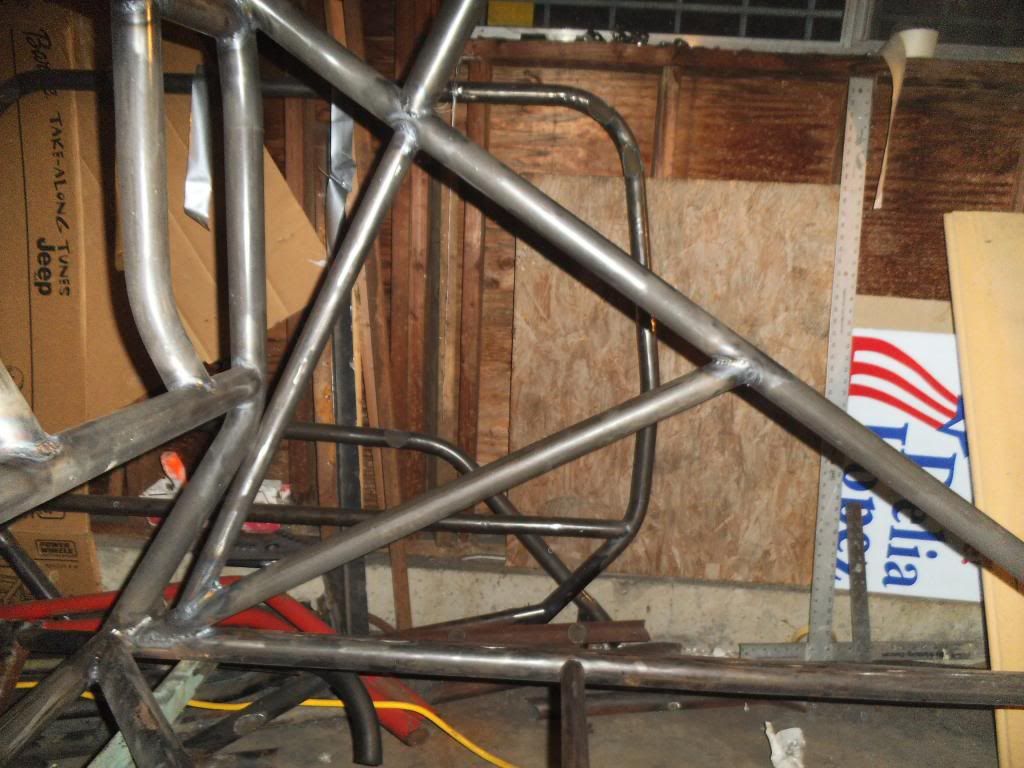
Searching the internet for a different piece of information I came across a post from someone on the SFI update committee, saying that they are planning to change the spec to require the dash bar to intersect the pillar bars at virtually the same location as the door X-bars. There is no limit on the distance in the specification, but in the "top secret decoder ring" handbook they give to chassis inspectors, they mention something like a maximum gap of 3x the diameter of the largest tube in the junction. This would have allowed me a 4.875" gap which I was planning to take advantage of, moving my dash bar as high as possible to clear the high pressure turbo.
I had already removed the old dash bar and welded in a replacement in this location:
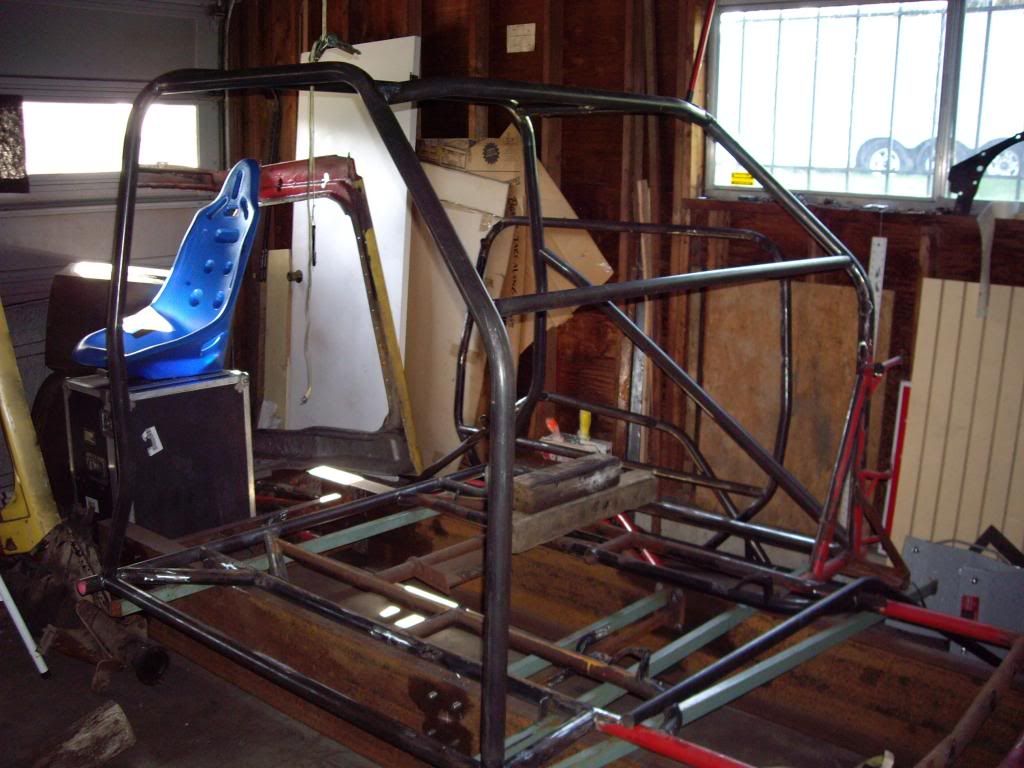
My chassis would get the certification 1st time out, but once the rule changes I would need to replace that tube for the next recertification (3 years later). I'd rather do it now and be good, so I switched to a bent dash bar to get the turbo clearance I needed:
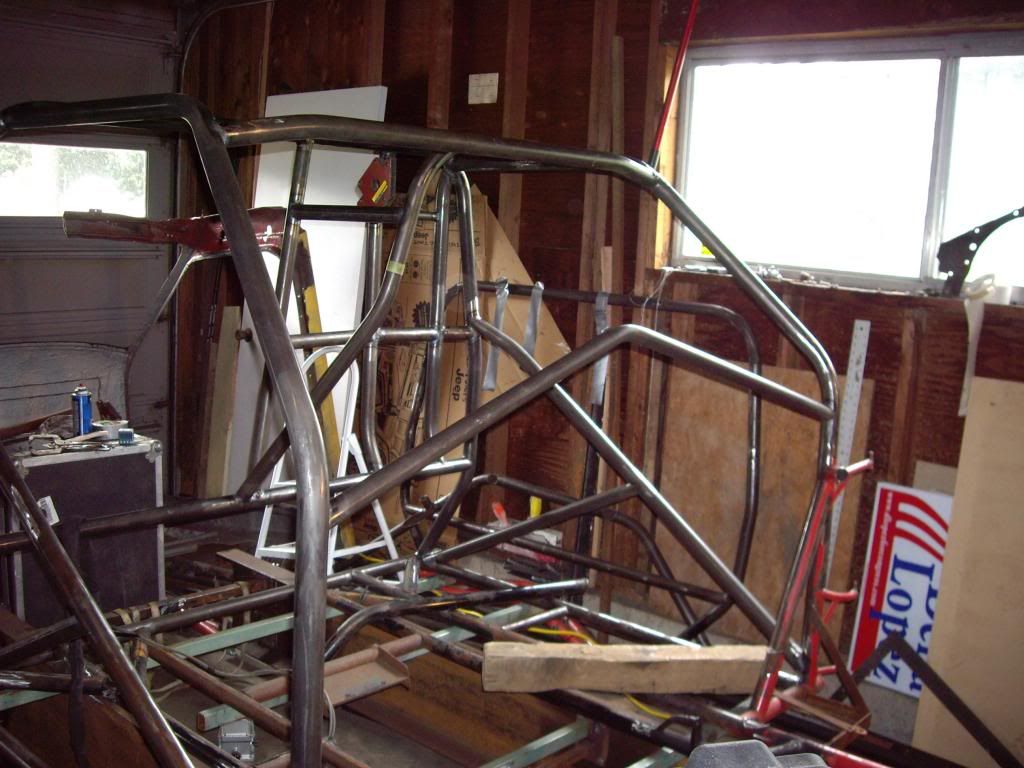
When it was time for the ISSPRO Pacific Coast Diesel Nationals I went ahead and mounted the cab & doors, so we could have something in our booth to attract attention. Fortunately this portion of the chassis is light enough to just slide off the jog:
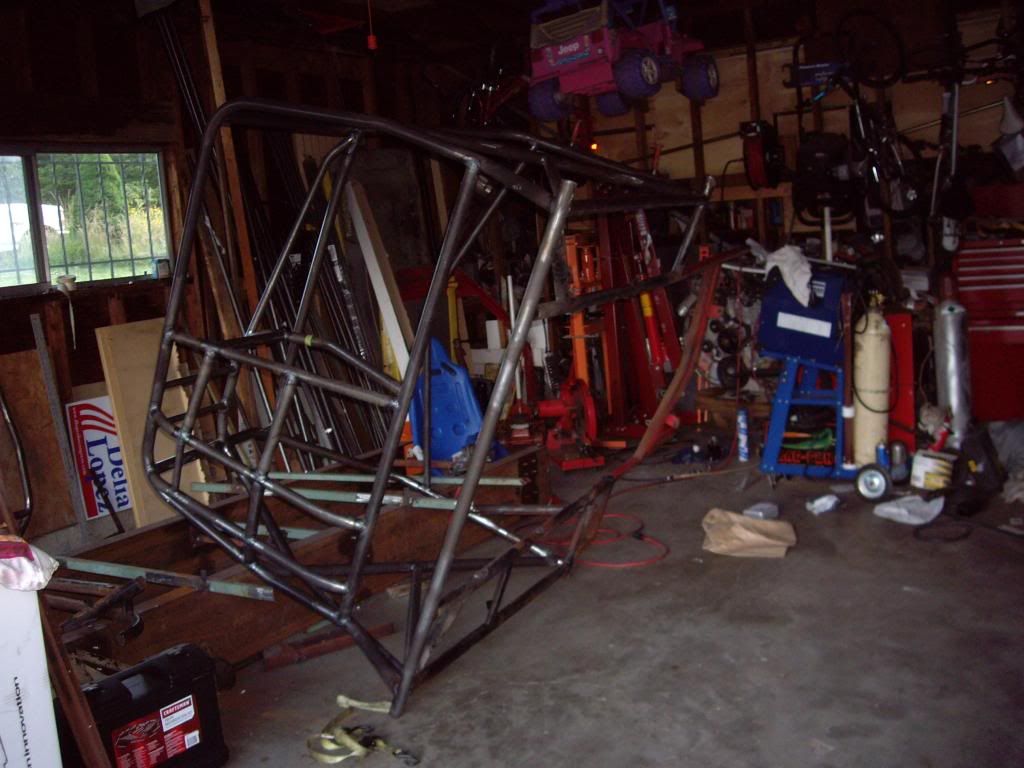
I started out carrying the thing "Fred Flintsone Style", but ended up tying it to a hand-truck with a ratchet strap.
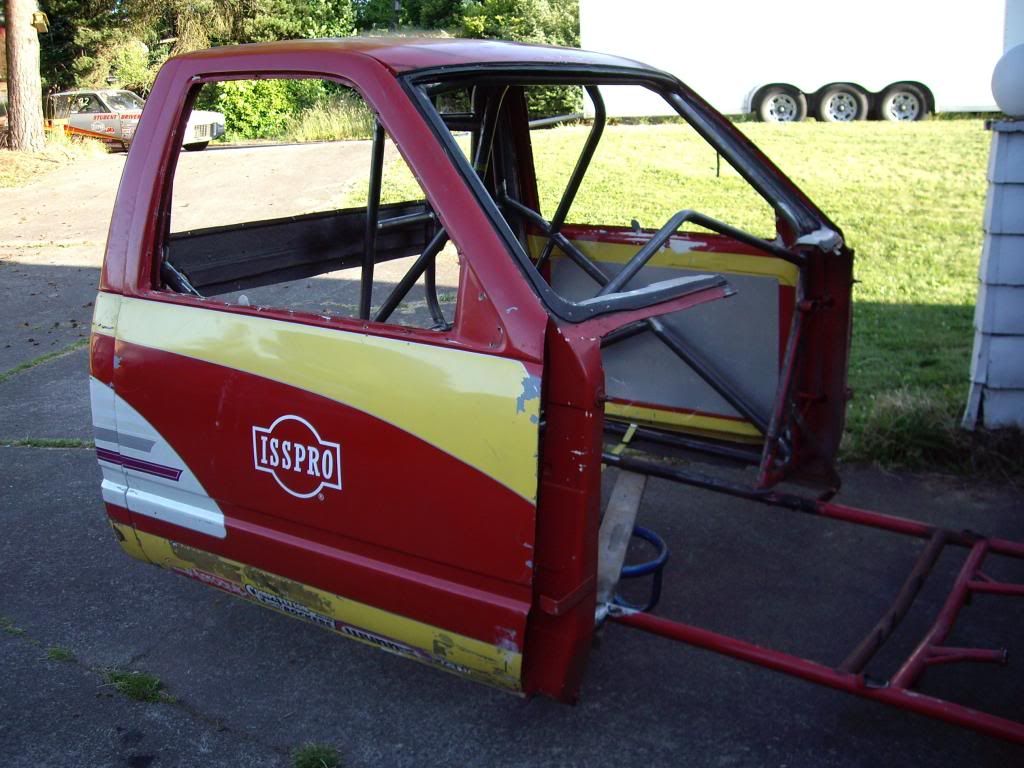
I had previously gotten written approval for how I wanted to build some portions of the cage, trying to meet the letter of the SFI spec even where it was difficult due to the shape of a truck versus the car chassis that the rules reflect. I didn't like the way I had to build it to meet the rules, but at least it met the letter of the rules (and I was adding some supplemental gussets to make me comfortable with the design). Unfortunately once they saw it in person and photos, they didn't like the way it laid out either. That whole issue brought my progress to a screeching halt! We went back and forth discussing alternatives, and it went all the way up to the head of NHRA's technical department, before we finally agreed on a design and has their written approval.
The key areas were the base of the main hoop. I planned to add some vertical gussets, but leave the required diagonal and "kidney bar" tubes continuous and make my gussets interrupted by those tubes (since the gussets aren't required by the spec). They came back and wanted me to do full diameter gussets that were not interrupted (which is the best thing for strength but technically violated the spec).
I was torn about whether to completely tear that whole area out and start over, or to try to "graft" the new tubes into place as well as I could. Since one tube (the kidney bar) was moving locations and getting shorter, I figured I would just remove it and replace it. Since the diagonals were already fully welded and in a position that would be difficult to grind and smooth when removing the old pieces, I decided to try to leave them and cut holes for the new gussets to pass through them.
Here is the passenger side after using the plasma cutter to rough in the cuts. I learned after these cuts that my electrode was worn on the cutter, which kept me from making very clean cuts.
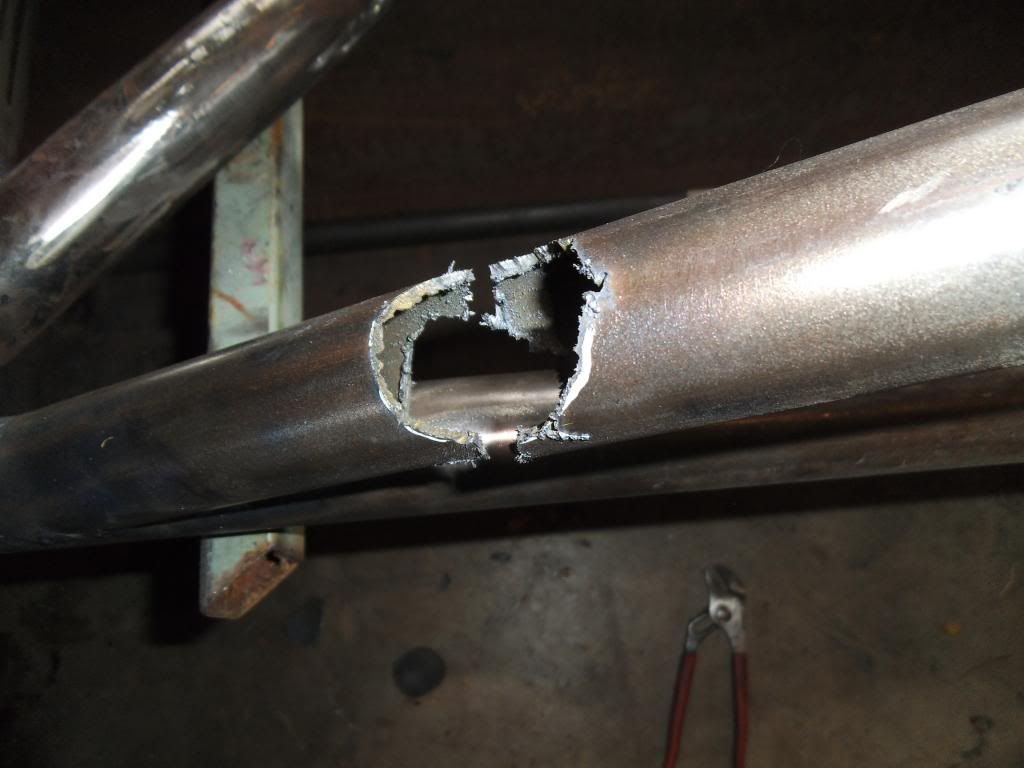
I used a short piece of tubing to check if I had notched enough for clearance, as the tube above kept me from easily dropping the actual length tube into place.
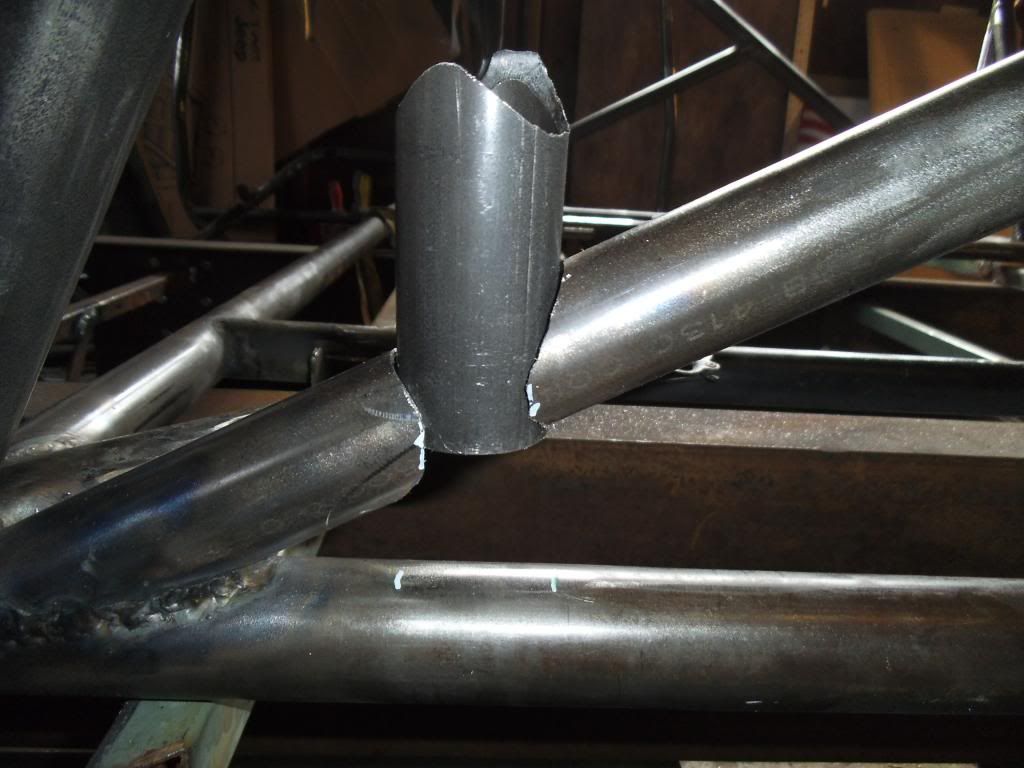
I had to use a ratchet strap to flex the diagonal out of the way to allow dropping the new bar into place.
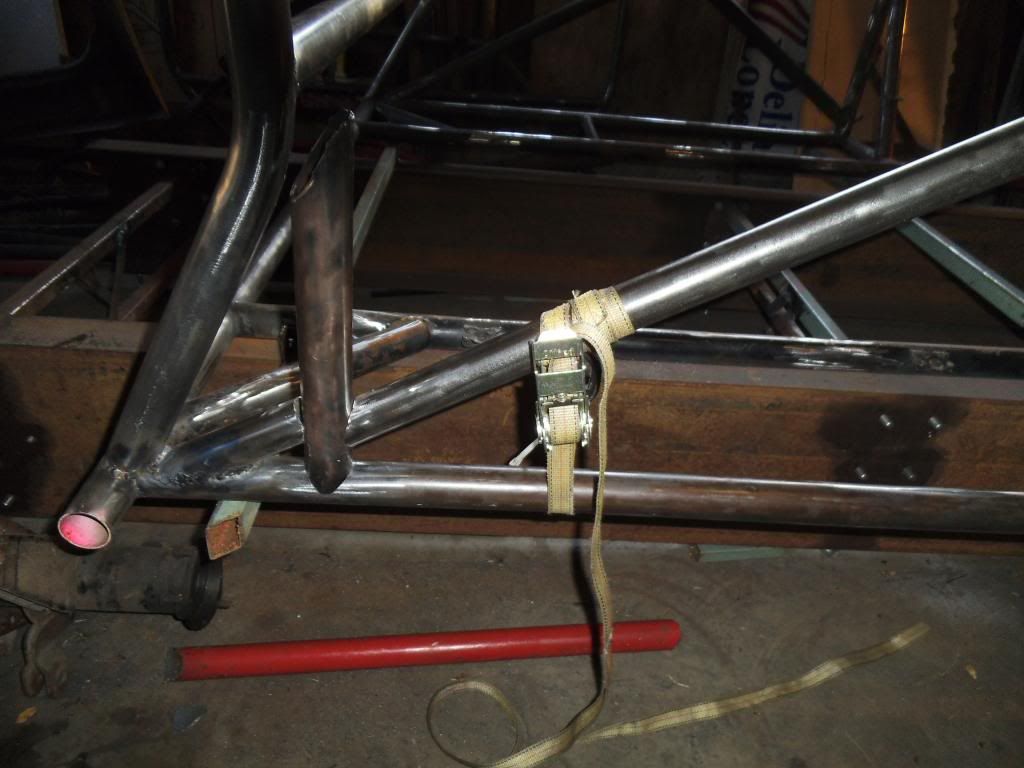
The driver's side was even more difficult since the door bar is bent outward (giving me more elbow room), which puts all these parts at slight angles.
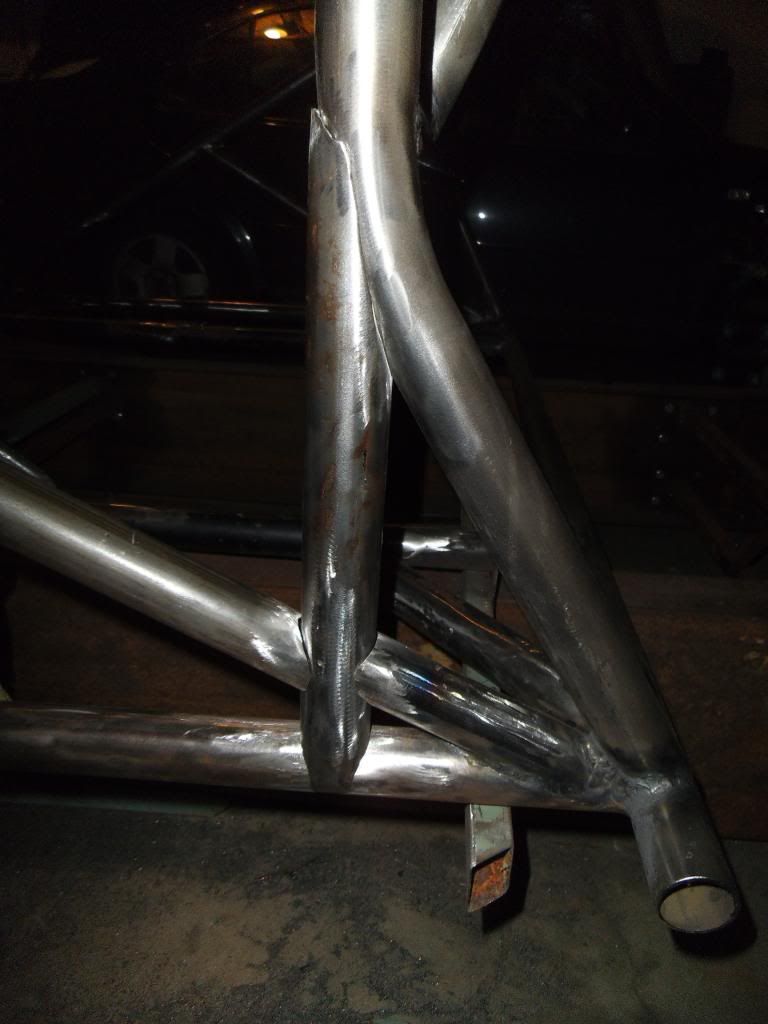
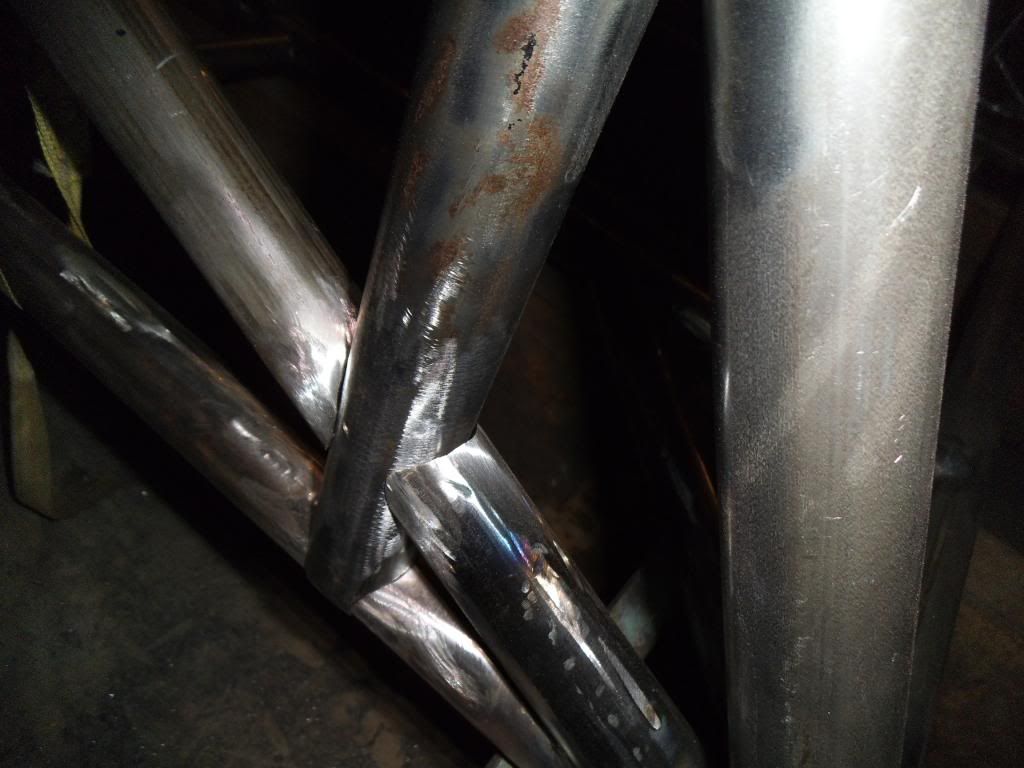
Here's a little detail you need to do when welding on a short section of tubing - a hole to allow the air in the tube to expand into one of the longer tubes. Without this, as you finish the last section of weld bead it may "blowout" from the air in the tube heating up. Been there, done that!
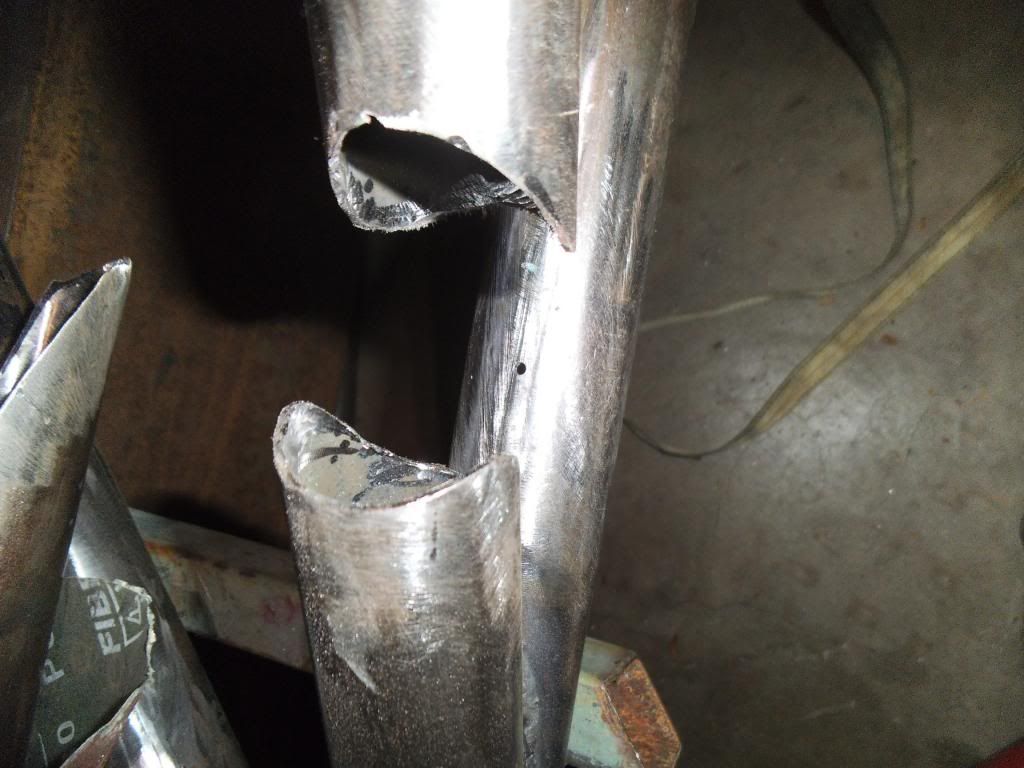

The new path for the kidney bar put it at a sharp angle with the tube it connected to, which precluded using my notcher to cut the required "fishmouth" shape, but a large carbide burr in an electric die grinder worked wonders for quickly shaping it.
With the replacement of the kidney bar, I was FINALLY back to the stage I was at on the project back in August!

While waiting for the NHRA decision I had plenty to keep me busy, between racing my Vega and working on my daughter's Junior Dragster.
Both of those endeavors provided success and mechanical failures! My daughter won her first event in her Jr:
I won a few events in the Vega, including a big bracket race that was complete with a big trophy and giant check. This race had some of the best bracket racers in the NW, I felt really fortunate to come out on top!
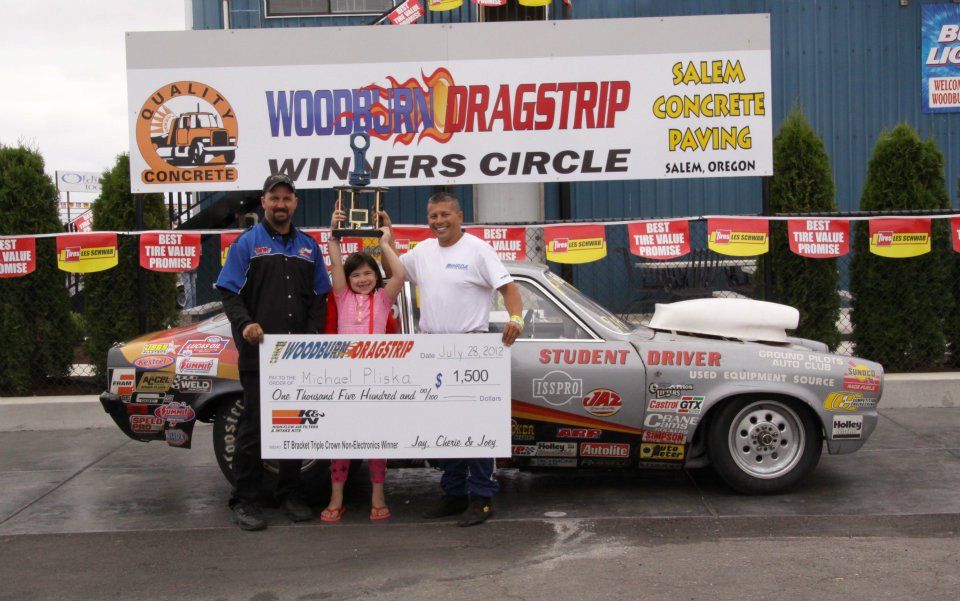
Unfortunately some bad things came along with the good. At a bracket race up in Bremerton I had a piston break towards the top end, and blasted out the sides of the block and oil pan. Despite having an engine diaper, the thing still locked up solid and sprayed a bunch of water and oil onto the tires. Fortunately Bremerton is built on a backup runway, and the guardrails are waaaaay off to the side, so I had plenty of room to do a 145+ mph slalom trying to bring it to a stop.
Back at the trailer I could see this was going to be expensive, as a huge crack was apparent in the cylinder head:

It appears that the #1 piston broke, and the rod and pin then flailed around and busted up everything in their path.
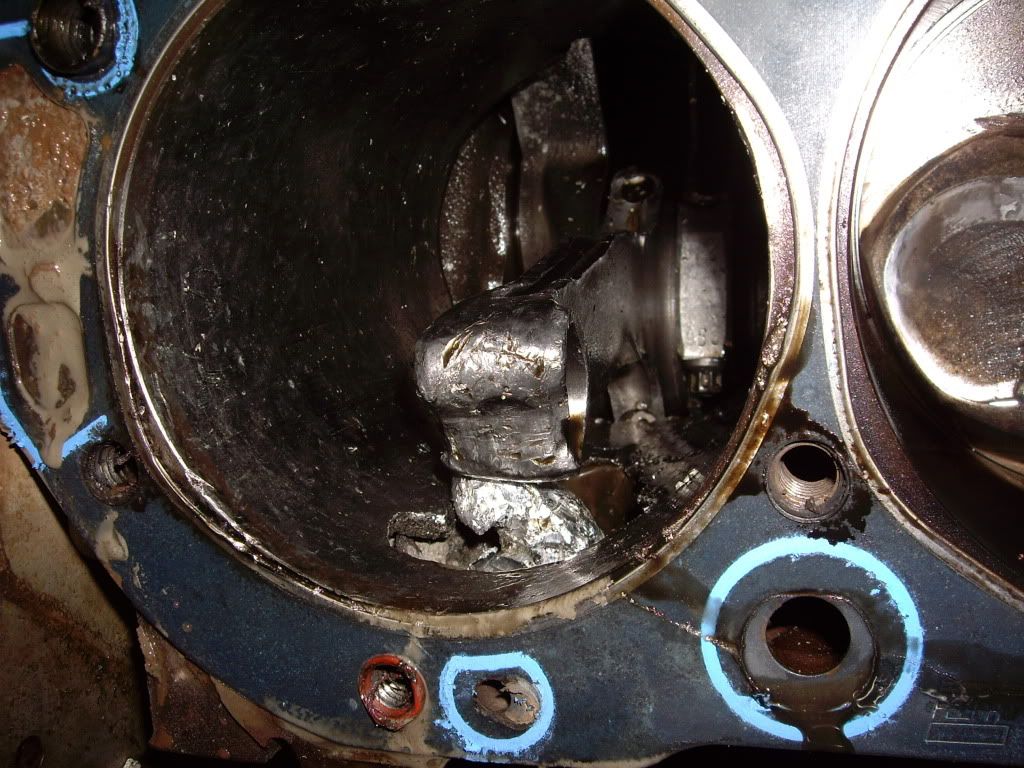
I was concerned since the very next race was the Race of Champions at the ET finals (which I was fortunate enough to qualify for the 2nd year in a row). I had a cracked cylinder wall at last year's RoC, and the car was smoking like crazy but I was winning rounds (got down to 5 cars left). I ended up buying a complete spare engine from a friend of a friend (ironically a few miles from the track I broke at, but of course a few days later so I had to make the trip twice). I didn't realize it at the time, but it appears I damaged the front pump on the transmission when the engine let loose, so the first pass at the RoC I ended up pumping all 10 quarts of ATF under the tires at the top end of the race track, and got to do another 145+ mph slalom (and miraculously kept it shiny side up and off the walls). A bunch of friends pitched in and we rebuilt my trans in the pits, and I was able to go a bunch of rounds on the Sunday race at the ET finals. I also went a bunch of rounds in my truck in a cash bash during the RoC (made it to the semis).
With my daughter's Jr, we had kept the engine slowed down with a restrictor plate on the intake. The engine was capable of mid-10's in the 1/8-mile, but as an 8 and 9 year old she was restricted to 12.90 and slower. I had picked up a couple of 8.90 engines, but learned that we needed a much better clutch to handle the additional power (and the good ones are built to order and take several weeks during the racing season). We went to the 1st race after her 10th birthday, planning to open up the old engine and let her run some 10's. Unfortunately the engine had other plans, as it broke a connecting rod right after firing it up to warm it up!
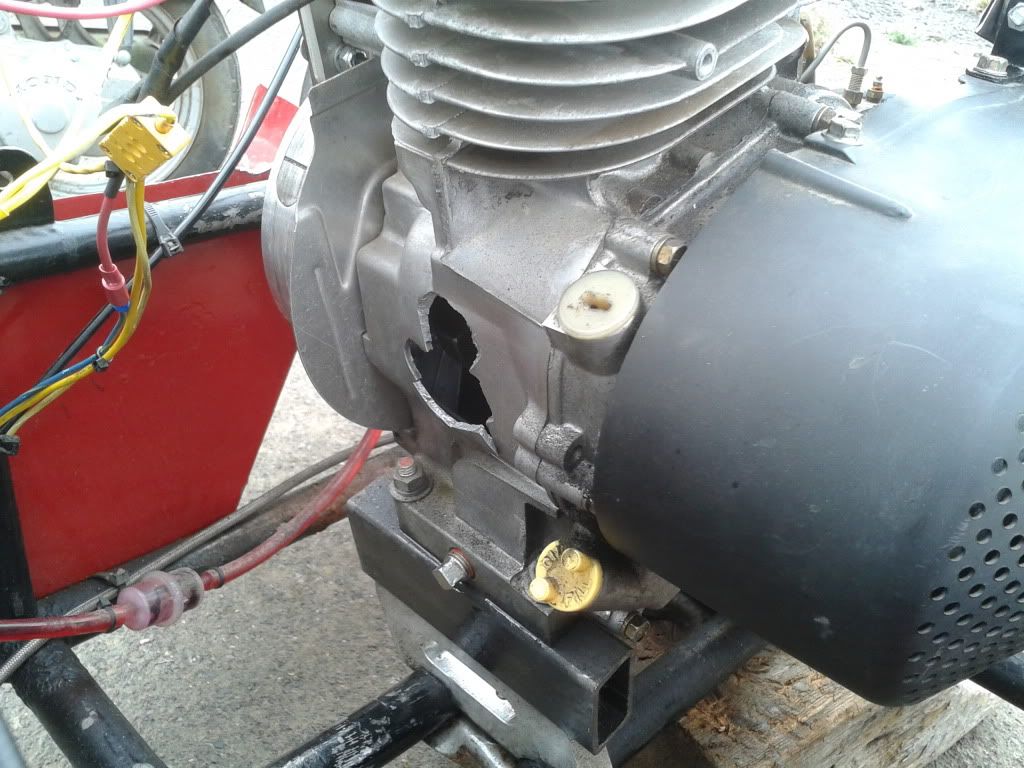
The worst part was seeing the disappointment on her face when she realized we weren't going to be racing that day.
Now that I have a much better idea of how long each task takes in the chassis build, I was able to create a project plan to help organize the remaining tasks and estimate a completion date. It now looks like I should get this whole thing done sometime in mid-June, just in time for the ISSPRO Pacific Coast Diesel Nationals!
I know, it's been forever since I posted an update here. The theme of this post is two steps forward, about 4 steps back, then finally getting back to where I was!
I finished up the Funny Car cage area that I was working on at the last entry, and also added the "kidney bar" that runs next to the driver.

Searching the internet for a different piece of information I came across a post from someone on the SFI update committee, saying that they are planning to change the spec to require the dash bar to intersect the pillar bars at virtually the same location as the door X-bars. There is no limit on the distance in the specification, but in the "top secret decoder ring" handbook they give to chassis inspectors, they mention something like a maximum gap of 3x the diameter of the largest tube in the junction. This would have allowed me a 4.875" gap which I was planning to take advantage of, moving my dash bar as high as possible to clear the high pressure turbo.
I had already removed the old dash bar and welded in a replacement in this location:

My chassis would get the certification 1st time out, but once the rule changes I would need to replace that tube for the next recertification (3 years later). I'd rather do it now and be good, so I switched to a bent dash bar to get the turbo clearance I needed:

When it was time for the ISSPRO Pacific Coast Diesel Nationals I went ahead and mounted the cab & doors, so we could have something in our booth to attract attention. Fortunately this portion of the chassis is light enough to just slide off the jog:

I started out carrying the thing "Fred Flintsone Style", but ended up tying it to a hand-truck with a ratchet strap.

I had previously gotten written approval for how I wanted to build some portions of the cage, trying to meet the letter of the SFI spec even where it was difficult due to the shape of a truck versus the car chassis that the rules reflect. I didn't like the way I had to build it to meet the rules, but at least it met the letter of the rules (and I was adding some supplemental gussets to make me comfortable with the design). Unfortunately once they saw it in person and photos, they didn't like the way it laid out either. That whole issue brought my progress to a screeching halt! We went back and forth discussing alternatives, and it went all the way up to the head of NHRA's technical department, before we finally agreed on a design and has their written approval.
The key areas were the base of the main hoop. I planned to add some vertical gussets, but leave the required diagonal and "kidney bar" tubes continuous and make my gussets interrupted by those tubes (since the gussets aren't required by the spec). They came back and wanted me to do full diameter gussets that were not interrupted (which is the best thing for strength but technically violated the spec).
I was torn about whether to completely tear that whole area out and start over, or to try to "graft" the new tubes into place as well as I could. Since one tube (the kidney bar) was moving locations and getting shorter, I figured I would just remove it and replace it. Since the diagonals were already fully welded and in a position that would be difficult to grind and smooth when removing the old pieces, I decided to try to leave them and cut holes for the new gussets to pass through them.
Here is the passenger side after using the plasma cutter to rough in the cuts. I learned after these cuts that my electrode was worn on the cutter, which kept me from making very clean cuts.

I used a short piece of tubing to check if I had notched enough for clearance, as the tube above kept me from easily dropping the actual length tube into place.

I had to use a ratchet strap to flex the diagonal out of the way to allow dropping the new bar into place.

The driver's side was even more difficult since the door bar is bent outward (giving me more elbow room), which puts all these parts at slight angles.


Here's a little detail you need to do when welding on a short section of tubing - a hole to allow the air in the tube to expand into one of the longer tubes. Without this, as you finish the last section of weld bead it may "blowout" from the air in the tube heating up. Been there, done that!


The new path for the kidney bar put it at a sharp angle with the tube it connected to, which precluded using my notcher to cut the required "fishmouth" shape, but a large carbide burr in an electric die grinder worked wonders for quickly shaping it.
With the replacement of the kidney bar, I was FINALLY back to the stage I was at on the project back in August!

While waiting for the NHRA decision I had plenty to keep me busy, between racing my Vega and working on my daughter's Junior Dragster.
Both of those endeavors provided success and mechanical failures! My daughter won her first event in her Jr:
I won a few events in the Vega, including a big bracket race that was complete with a big trophy and giant check. This race had some of the best bracket racers in the NW, I felt really fortunate to come out on top!

Unfortunately some bad things came along with the good. At a bracket race up in Bremerton I had a piston break towards the top end, and blasted out the sides of the block and oil pan. Despite having an engine diaper, the thing still locked up solid and sprayed a bunch of water and oil onto the tires. Fortunately Bremerton is built on a backup runway, and the guardrails are waaaaay off to the side, so I had plenty of room to do a 145+ mph slalom trying to bring it to a stop.
Back at the trailer I could see this was going to be expensive, as a huge crack was apparent in the cylinder head:

It appears that the #1 piston broke, and the rod and pin then flailed around and busted up everything in their path.

I was concerned since the very next race was the Race of Champions at the ET finals (which I was fortunate enough to qualify for the 2nd year in a row). I had a cracked cylinder wall at last year's RoC, and the car was smoking like crazy but I was winning rounds (got down to 5 cars left). I ended up buying a complete spare engine from a friend of a friend (ironically a few miles from the track I broke at, but of course a few days later so I had to make the trip twice). I didn't realize it at the time, but it appears I damaged the front pump on the transmission when the engine let loose, so the first pass at the RoC I ended up pumping all 10 quarts of ATF under the tires at the top end of the race track, and got to do another 145+ mph slalom (and miraculously kept it shiny side up and off the walls). A bunch of friends pitched in and we rebuilt my trans in the pits, and I was able to go a bunch of rounds on the Sunday race at the ET finals. I also went a bunch of rounds in my truck in a cash bash during the RoC (made it to the semis).
With my daughter's Jr, we had kept the engine slowed down with a restrictor plate on the intake. The engine was capable of mid-10's in the 1/8-mile, but as an 8 and 9 year old she was restricted to 12.90 and slower. I had picked up a couple of 8.90 engines, but learned that we needed a much better clutch to handle the additional power (and the good ones are built to order and take several weeks during the racing season). We went to the 1st race after her 10th birthday, planning to open up the old engine and let her run some 10's. Unfortunately the engine had other plans, as it broke a connecting rod right after firing it up to warm it up!

The worst part was seeing the disappointment on her face when she realized we weren't going to be racing that day.
Now that I have a much better idea of how long each task takes in the chassis build, I was able to create a project plan to help organize the remaining tasks and estimate a completion date. It now looks like I should get this whole thing done sometime in mid-June, just in time for the ISSPRO Pacific Coast Diesel Nationals!
Thanks guys! It really feels good to get back to work on this project. Too bad my kid still watches some TV because otherwise I'd cancel cable, I have all the "entertainment" I need with this project!

